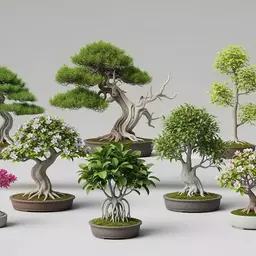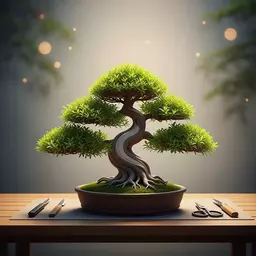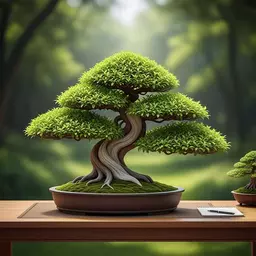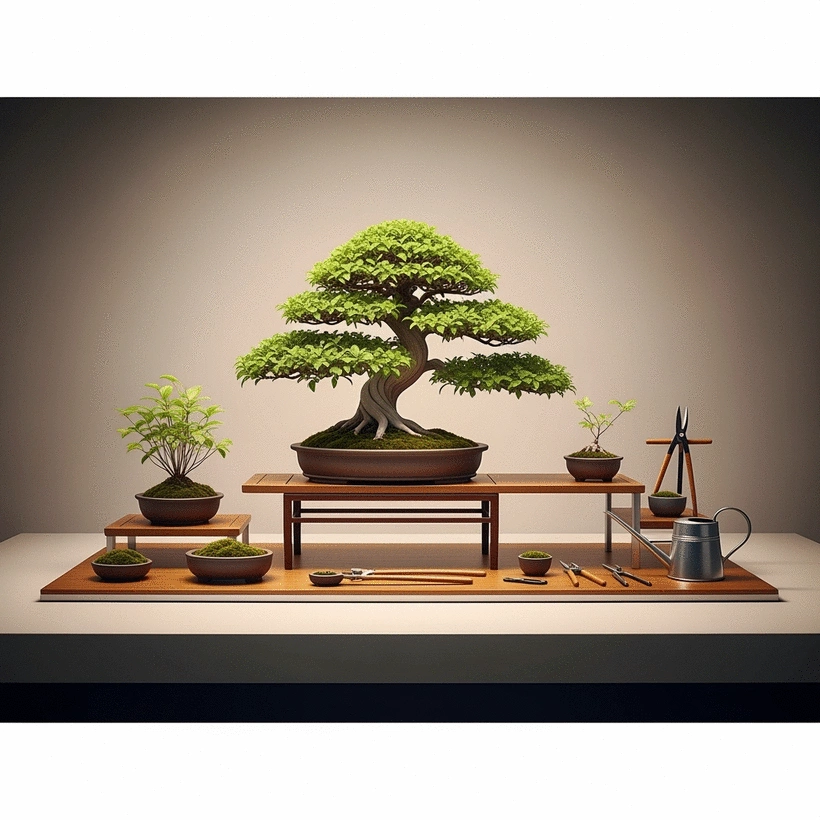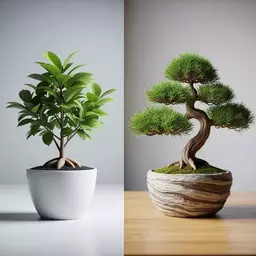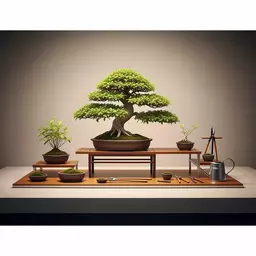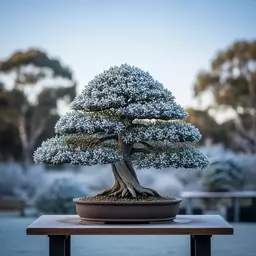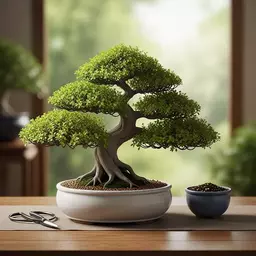Bonsai Trees: 10 Easy Species
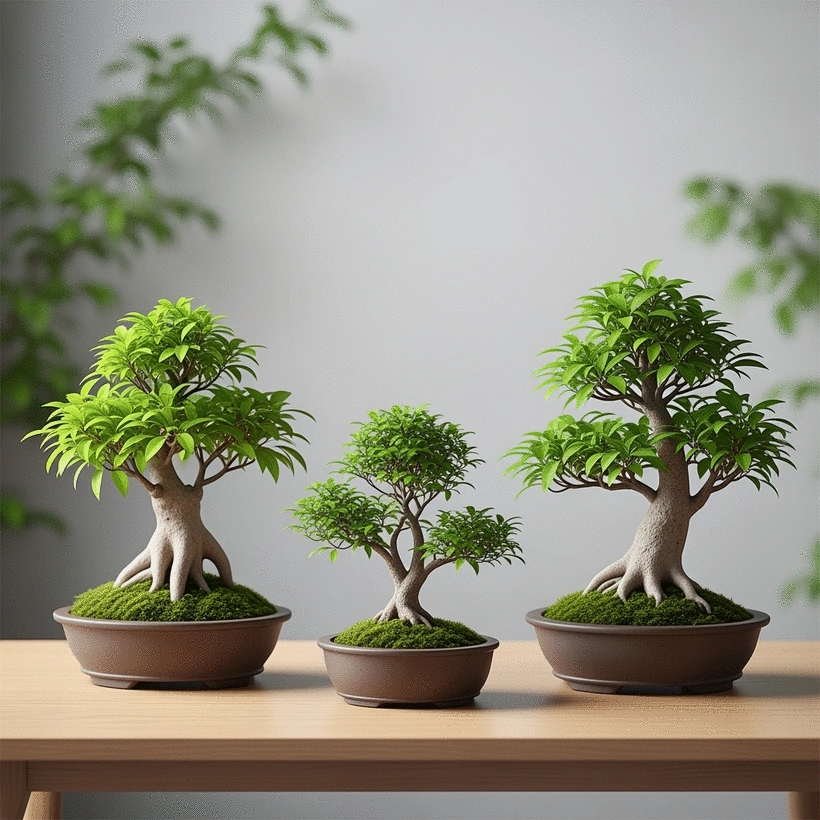
Caring for a bonsai is not just about gardening; it's an artistic journey that invites you to reflect on life, patience, and creativity. Each tree is a canvas awaiting your touch, a living testament to the connection between nature and nurturer. Ready to explore the transformative world of bonsai?
What You Will Learn
- The essence of bonsai cultivation as a blend of art, patience, and creativity.
- Key traits to look for in beginner-friendly bonsai species, such as hardiness and growth rate.
- A curated list of the top 10 bonsai tree species ideal for beginners.
- Ways to engage with the bonsai community for support and inspiration on your journey.
Bonsai for Beginners: Traits and Top 10 Species
Starting your bonsai journey is exciting! This visual highlights key traits to look for in beginner-friendly bonsai and introduces you to ten species perfect for cultivation.
Key Traits for Beginner Bonsai Trees
- ✓ Hardiness: Withstand care fluctuations.
- ✓ Growth Rate: Provide visible progress.
- ✓ Forgiveness: Recover from pruning/repotting.
Top 10 Beginner-Friendly Bonsai Species
Understanding Bonsai: A Beginner's Guide to Tree Species
Have you ever wondered what it takes to cultivate a bonsai tree? At Shire Bonsai, we believe that understanding the essence of bonsai is the first step in your journey. Bonsai is not just about growing miniature trees; it's about creating a living piece of art that reflects your style and creativity. Choosing bonsai allows you to connect with nature in a profound way, nurturing a unique story within each tree.
But why should you choose bonsai? For one, it offers a fulfilling blend of patience, artistry, and horticulture. Each tree represents a journey of care and dedication, which can be incredibly rewarding! As you learn and grow alongside your bonsai, you'll find a sense of peace and accomplishment that enriches your life.
What is Bonsai and Why Choose It?
Bonsai is the ancient art of cultivating trees in small pots, effectively mimicking the appearance of full-sized trees in nature. This practice originated in China and was later refined in Japan, becoming an expression of cultural values and aesthetics. For a deeper understanding of bonsai cultivation techniques and tree care, the Virginia Cooperative Extension offers comprehensive guides. The beauty of bonsai lies in its ability to capture the essence of nature, allowing you to bring a piece of the outdoors into your home.
- Creativity: Bonsai cultivation encourages your artistic expression.
- Mindfulness: Caring for a bonsai can be a meditative experience.
- Connection: It fosters a deeper connection to nature and its cycles.
Choosing bonsai is about more than just having a plant; it's about embracing a lifestyle that promotes patience and appreciation for life's intricate details. Each tree has its unique characteristics and care requirements, further enhancing the journey!
Key Traits of Bonsai Trees Suited for Beginners
If you're just stepping into the world of bonsai, it's essential to consider some traits that make certain species easier to care for. A beginner-friendly bonsai tree should be resilient, adaptable, and forgiving of minor mistakes. Here are some traits to look for:
- Hardiness: Choose a tree that can withstand fluctuations in care.
- Growth Rate: Select species that grow relatively quickly, providing visible progress.
- Forgiveness: Opt for trees that can recover from pruning and repotting.
These characteristics will not only help you succeed but also deepen your appreciation for the artistry of bonsai. As you gain experience, you'll discover which traits resonate with your style and preferences, paving the way for a fulfilling bonsai journey!
Top 10 Bonsai Tree Species for Beginners
Now that we've covered the basics, let's delve into the top ten bonsai tree species that are perfect for beginners. Each of these trees offers unique attributes that can enrich your experience with bonsai cultivation.
- Chinese Elm: A Resilient Choice
- Ficus: The Indoor Favorite
- Juniper: Classic Outdoor Bonsai
- Japanese Maple: Aesthetic Appeal
- Japanese Black Pine: For the Adventurous Beginner
- Dwarf Jade: Easy and Affordable
- Schefflera: Thriving Indoors
- Chinese Privet: A Hardy Option
- Boxwood: Perfect for Beginners
- Teak: Unique but Manageable
With these species, you'll find options that cater to various environments, including both indoor and outdoor settings. Each tree not only brings beauty into your life but also invites you to explore the art of bonsai further! For more detailed information on specific species and their care, resources like the Missouri Botanical Garden offer valuable insights for enthusiasts.
Pro Tip
As you embark on your bonsai journey, remember to observe your tree closely. Each species has its unique personality and preferences. Take notes on how it responds to different watering schedules, light conditions, and pruning techniques. This practice not only enhances your understanding but also deepens your connection with your bonsai as it evolves over time!
Frequently Asked Questions About Bonsai for Beginners
- What is bonsai?
- Bonsai is the ancient art of cultivating trees in small pots, mimicking the appearance of full-sized trees in nature. It's a blend of horticulture and artistic expression.
- Why should I choose bonsai?
- Bonsai offers a fulfilling blend of patience, artistry, and horticulture. It provides a meditative experience, encourages creativity, and fosters a deeper connection to nature.
- What key traits should I look for in a beginner-friendly bonsai tree?
- Beginner-friendly bonsai trees should be hardy, have a relatively quick growth rate for visible progress, and be forgiving, meaning they can recover from minor mistakes in pruning or repotting.
- What are some top bonsai tree species recommended for beginners?
- Top species for beginners include Chinese Elm, Ficus, Juniper, Japanese Maple, Japanese Black Pine, Dwarf Jade, Schefflera, Chinese Privet, Boxwood, and Teak.
- How can I engage with the bonsai community?
- You can engage with the bonsai community by joining online forums or social media groups, attending local bonsai clubs or workshops, submitting photos of your bonsai journey, and asking questions or sharing tips with other enthusiasts.
Wrapping Up Your Bonsai Experience
As we conclude this journey into the world of bonsai, I want to encourage every new enthusiast out there! Whether you've just taken your first cut or are considering your options, remember that bonsai cultivation is a beautiful blend of patience and creativity. The joy comes not just from the end result but from the nurturing process itself. Each leaf and branch tells a story of your dedication and care!
At Shire Bonsai, we’re here to support you in every step of your bonsai adventure. Don’t hesitate to explore the resources we offer and connect with our community. Remember, every expert was once a beginner, just like you!
Encouragement for New Bonsai Enthusiasts
Starting your bonsai journey can feel overwhelming, but here’s the good news: you’re not alone! Many have walked this path, and by embracing the process, you’ll find plenty of support. Here are a few tips to keep you motivated:
- Set small, achievable goals – each pruning session is a step forward!
- Celebrate your progress – take photos to document your tree's growth.
- Join online forums or social media groups dedicated to bonsai for inspiration and tips.
Each of these actions helps create a sense of community, reminding you that bonsai is not just about the trees; it's about the connections we make along the way!
Next Steps: Where to Buy and Community Resources
Now that you have a basic understanding of bonsai cultivation, it’s time to explore where you can find the perfect tree to start your journey. Here are some recommended resources:
- Local nurseries: Often have a selection of bonsai species suited for beginners.
- Online bonsai retailers: Websites like Shire Bonsai offer a variety of options, complete with detailed care guides.
- Bonsai exhibitions: Visiting these can provide firsthand experience and inspiration!
Additionally, consider engaging with local bonsai clubs or workshops. They can offer hands-on experience and valuable insights from seasoned bonsai masters.
Interactive Bonsai Community Engagement
Sharing Your Bonsai Journey: Submit Your Photos
We’d love to see the progress of your bonsai journey! At Shire Bonsai, we encourage you to document your tree's transformation and share it with us. It’s a wonderful way to reflect on your growth and connect with fellow enthusiasts. You might even inspire someone else to start their own bonsai adventure!
Join the Conversation: Questions and Tips from Other Beginners
Your questions matter! Engaging with others in the bonsai community can be incredibly beneficial. Don’t hesitate to post your queries or share helpful tips you’ve discovered along the way. Other beginners will appreciate your insights, and you may receive valuable advice in return.
- What challenges have you faced with your bonsai?
- What tips can you offer on specific care techniques?
- How has bonsai cultivation impacted your life?
Building these conversations can foster a supportive environment that enriches everyone’s experience!
Exploring Bonsai Clubs and Workshops for Deeper Learning
For those eager to dive deeper into the world of bonsai, I highly recommend exploring local clubs and workshops. These spaces are treasure troves of knowledge and community support. Here’s why you should consider joining:
- Hands-on experience: Learn directly from experienced bonsai artists.
- Feedback on your work: Get constructive critiques to improve your skills.
- Networking opportunities: Meet fellow bonsai enthusiasts who share your passion.
By joining a bonsai club or attending workshops, you’ll not only enhance your skills but also build lasting friendships with people who understand the joys and challenges of this art form.
Recap of Key Points
Here is a quick recap of the important points discussed in the article:
- Understanding Bonsai: Bonsai is an art form that cultivates trees in small pots, reflecting nature's beauty and allowing for personal expression.
- Choosing Beginner-Friendly Trees: Look for species that are hardy, have a manageable growth rate, and are forgiving in care to enhance your bonsai journey.
- Top Species for Beginners: Recommended trees include Chinese Elm, Ficus, and Juniper, each offering unique traits that cater to novice cultivators.
- Community Engagement: Engage with online forums and local clubs for support, inspiration, and resources as you progress in your bonsai cultivation.
- Embrace the Process: Celebrate small achievements in bonsai care, fostering a deeper connection with your trees and the art of cultivation.
